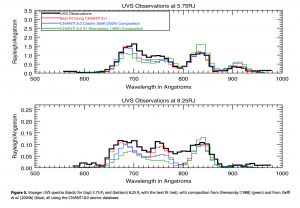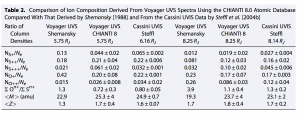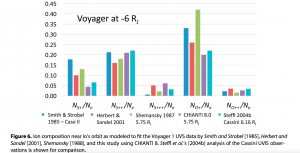Voyager UVS Spectral Analysis
Here is a link to the UV Torus emissions bibliography
Recent re-analysis of Voyager UVS spectrum of the Io torus can be found in:
Nerney, E. G., Bagenal, F., Steffl A. J. (2017). Io Plasma Torus Ion Composition: Voyager, Galileo, Cassini, J. Geophys. Res., Jan 2017, DOI: 10.1002/2016JA023306
The LASP group has used CHIANTI for their spectral analysis of the Voyager UVS spectra. Documentation about how we simulate a spectrum using CHIANTI is provided here: CHIANTI_Emiss_Documentation
All the necessary IDL code to simulate a spectrum, with the exception of the CHIANTI database version 8.0.7 and accompanying routines, can be found here: Emiss_Code.zip
The CHIANTI database version 8.0.7 and accompanying routines can be found here: CHIANTI
Having calibrated our spectral fitting technique on the Cassini UVIS data, we turn to the Voyager UVS spectrum to determine what ion composition we find best matches the data using the CHIANTI 8 atomic database. The Figure below shows Voyager UVS spectra obtained at the torus ansa distances of 5.75 and 8.25 RJ. These are two spectra analyzed by Donald Shemansky and published in Bagenal et al. (1992). The analysis of these spectra is discussed in Shemansky (1988). In this study we used the Voyager 1 pre-Jupiter encounter calibration curve provided by Jay Holberg (private communication) to convert counts per channel to Rayleighs per Angstrom.
Using the Cassini data as a guide, we fit the two Voyager spectra with the electron density profile above and a fixed O+/O++ ratio of 8 at 5.75 RJ and of 2 at 8.25 RJ to obtain our best fit ion composition. We also show the results of using CHIANTI 8 to show the predicted emissions for the ion composition derived from these spectra by Shemansky (1988) and from the Cassini UVIS data for these distances by Steffl et al. (2004b). In the table below we compare our best fit of the UVS observations using the CHIANTI 8.0 database with these previous analyses.
At 5.75 RJ we are able to obtain a reasonable match to the data with a composition that is very similar to the Cassini-based composition of Steffl et al. (2004b). In his earlier analysis of the Voyager spectrum Shemansky (1988) derived a substantially higher oxygen abundance. We take the Shemansky (1988) composition and use the CHIANTI 8 emission rates to produce a synthetic Voyager UVS spectrum for comparison in the figure above. The Shemansky (1988) composition overestimates the emission in the 833—834 A feature. Similarly, the sulfur features (650—750 A) are underestimated by the Shemansky (1988) composition. The table above also shows the composition from Steffl et al (2004) for comparison. The composition from our analysis of the Voyager spectrum is more consistent with the analysis of Cassini UVIS data by Steffl et al (2004) than with Shemansky (1988). It is interesting to note that our re-analysis of the Voyager data also quite closely matches the composition derived from the Voyager data by Smith & Strobel (1985).
The figure below shows a summary bar chart of the different abundances of the five major ions in the torus (~6 RJ) derived from Voyager 1 data by Smith & Strobel (1985), Shemansky (1988), Herbert & Sandel (2000), and this study (using CHIANTI 8). We also include Steffl et al. (2004b)’s analysis of Cassini UVIS data for comparison.
We found it much harder to find a good match to the Voyager spectrum at 8.25 RJ, particularly at around 800 A where there are no strong lines expected. Again, the Shemansky (1988) composition (using the CHIANTI 8.0 atomic data) overestimates the oxygen emission at 833—834 A and underestimates the sulfur emissions. The Cassini composition derived using CHIANTI 8.0 suggests a similar amount of oxygen ions to that derived by Steffl et al. (2004b) and from our analysis of the Voyager spectra, but less sulfur ions than Voyager at 8.25 RJ. Our analysis using the CHIANTI 8.0 database finds a slightly better match to the 8.25 RJ Voyager spectrum but with a composition that is closer to the Steffl et al. (2001b)’s analysis of Cassini data than the Shemansky (1988) composition. Specifically, we find less oxygen, less of a change in ionization state with radial distance, and overall, the ionization state of sulfur is higher than found by Shemansky (1988).



